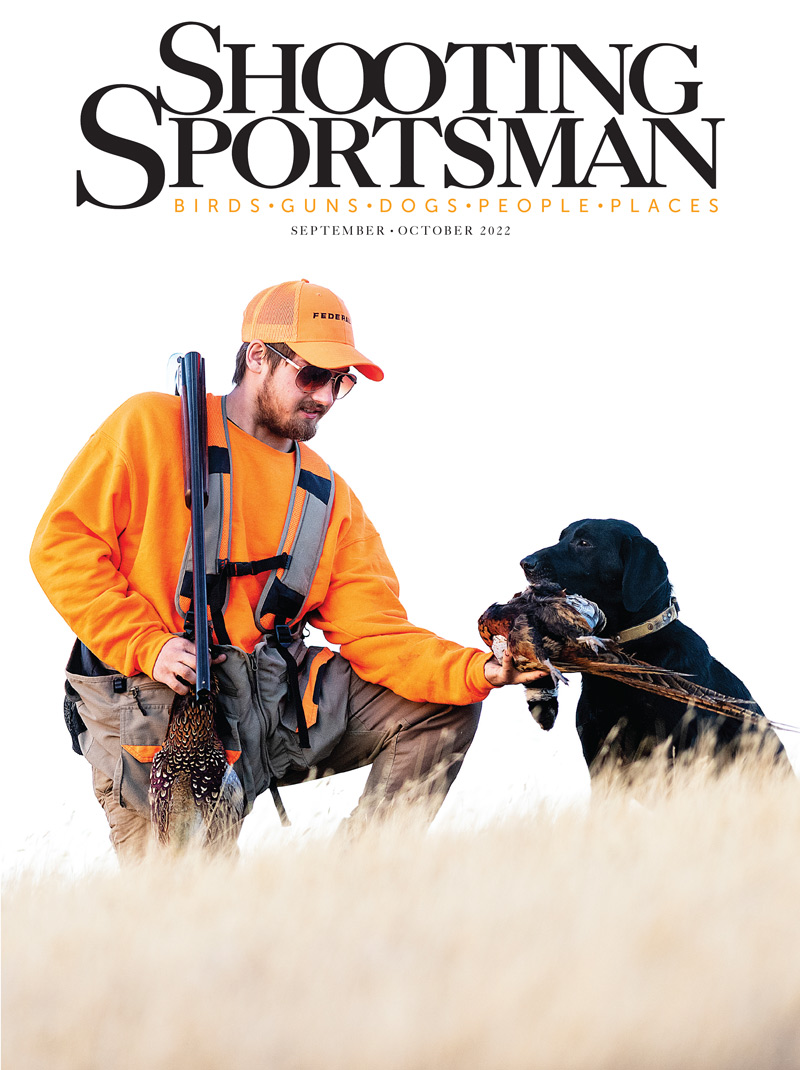Training a flushing dog to efficiently hunt pheasants and other upland birds isn’t difficult, but it requires more strategy than turning the dog loose and hoping for the best. If your dog has plenty of bird-seeking drive, that’s great. Let’s talk about how to keep that drive under control.
Many hunters go after pheasants with the same retrievers they use to hunt ducks. When you think about it, these two pursuits couldn’t be more different. Retrieving ducks requires a dog to use its eyes to mark downed birds and run straight lines to pick them up, sometimes at long distances; flushing pheasants means the dog using its nose in cover that often offers limited visibility and searching from side to side within gun range. Without training, who could really blame a retriever for chasing a rooster over the hill and out of sight?
Make it a goal to train your flushing dog to hunt in control; you’re running the hunt, not your dog. That means making sure your dog stays within gunshot range and obeys commands at any distance.
Hunting in Range
I don’t do a lot of upland training with young retrievers if they are going to be primarily waterfowl dogs. My first priority is training for good marking skills and blind retrieves. Once that foundation is in place, then I feel confident I won’t undo that progress with some upland training.
The first time out, I’ll plant a live pigeon in a short-grass training field, always placing it at the outer edge of the cover. This is important. If you plant birds in the center of the field and run your dog into the wind, guess what happens when the dog picks up scent? It will get the bird alright, but you won’t be the one in control.
With a pigeon tucked away in the grass, it’s just a matter of guiding the dog left or right as you walk in a zig-zag pattern. I’ll use different language than I use during waterfowl training. I might say, “Hunt ’em up!” or “Find the bird!” as we head into the field, but I keep talking to a minimum. As you work toward the planted bird, make sure your dog ends up downwind of the pigeon. Your dog might catch the bird or it might flush the pigeon, giving you a chance to shoot it. Repeat in all sorts of different cover whenever you have the opportunity, and work on control before and after the flush so you’ll be ready when the season rolls around.
Pheasant hunting success happens when your dog is hunting for you, not for itself.
Before flushing-dog purists accuse me of skipping a lot of steps, keep in mind that I’m talking about a retriever that already has plenty of bird experience. I’m just helping the dog learn that when we’re in upland mode, all of the fun happens in here near me and not out there on the horizon.
Help from the E-Collar
I have no doubt that many hunters use e-collars as long-distance remedies for dogs that are hunting too far out of range. That’s an individual decision, but you have to be fair to your dog by not hitting the transmitter button out of frustration if you didn’t do the prep work to teach your dog to hunt within range.
Another use for the e-collar that cuts down on the need for corrections and keeps the hunt flowing more smoothly is the tone and/or vibration feature. This is a great option for communicating at a distance. You can tie tone or vibe to any command you want.
For pheasant hunting, my dogs know what range is acceptable, and, yes, I’ll give them a correction if they start drifting out beyond that 20-yard sweet spot. But the vibe is a warning that means, Hey buddy, you’re pushing it. You’d better slow down, change direction or check back with me before you get any farther away.
Stopping the Chaos
You’ve no doubt experienced a chaotic pheasant hunt where you spent too much of the day watching birds sail into the next county while being chased by happy-but-ill-mannered dogs. It follows that you should understand the value of being able to stop a dog at a distance.
I believe every hunting dog should obey the whistle-sit command. One strong whistle blast means, Stop what you’re doing and stay stopped until I give you a different command. Training for this can start at home in your yard, simply by trading the word “Sit” for the whistle blast. When a hunt starts to go sideways (and skittish roosters can have that effect through no fault of yours or your dog’s), sometimes it’s best to just stop everything and regroup. If you can stop your dog at any distance until you, your buddies and your dog can regain composure, the rest of your hunt just might improve.
If your dog ignores the whistle and you need to reinforce with the e-collar, make sure your dog knows what it’s being corrected for. Repeated e-collar pressure on a soft dog could result in the dog not wanting to hunt in front of you at all. You’re better off teaching the whistle-sit and then using the e-collar only as a backup.
Pheasant hunting success happens when your dog is hunting for you, not for itself. Getting your dog to understand that with some goal-oriented training will pay off with more birds in the bag.
Jessie Richards owns and operates Full Throttle Kennel, in Campbellsport, Wisconsin, and trains in Boston, Georgia, during the winter. She specializes in training retrievers for upland and waterfowl hunting and competes in AKC field trials. In addition to guiding in the fall, Richards spends Octobers waterfowl hunting in Saskatchewan.
Buy This Issue!
Read our Newsletter
Stay connected to the best of wingshooting & fine guns with additional free content, special offers and promotions.





